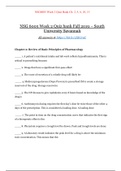Samenvatting
Summary thermodynamics for biomedical engineering & pharmacy at the RUG (WBFA021)
- Instelling
- Rijksuniversiteit Groningen (RuG)
Summary of all content of the given lectures of thermodynamics for biomedical engineering & pharmacy students at the RUG. It is summarized in the order of the given lectures. All important formulas and graphs are included and explained.
[Meer zien]














